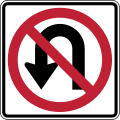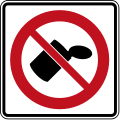No symbol

The no symbol (also known as a prohibition sign, no sign, circle-backslash symbol, nay, interdictory circle, or universal no) is a circle with a diagonal line through it (running from top left to bottom right), surrounding a pictogram used to indicate something is not permitted. The no symbol is generally colored red, but is sometimes another color, typically black.
The Unicode code point for the prohibition sign (also called the no symbol) is U+20E0;, Combining Enclosing Circle Backslash ( ⃠ ). It is a combining character, which means that it appears on top of the character before it, so putting d⃠ will show d⃠. . It also appears in the Webdings and Wingdings 2 fonts.
There is also a prohibition sign emoji located at U+1F6AB NO ENTRY SIGN (🚫), which does not combine with anything.[1]
According to the ISO standard (and also under a UK Statutory Instrument), the red area must take up at least 35 percent of the total area of the sign within the outer circumference of the "prohibition sign". Therefore, 35 percent of everything within the outer edge of the "no symbol" must be the symbol. Additionally, for printed signs under the UK rules, the width of a "no symbol" is set at 80 percent the height of the area to which it is printed.
Uses
The "prohibition" symbol is used on traffic signs, so that drivers can interpret traffic laws quickly while driving. For example:
-
 No left turn or
No left turn or  No right turn
No right turn -
 No U-turn
No U-turn -
 No parking (English) or
No parking (English) or .svg.png) No estacionarse (Spanish)
No estacionarse (Spanish)
Sometimes the symbol is used to warn drivers who are not driving motorized vehicles of dangers or prohibitions:
-
 No hitchhiking
No hitchhiking -
 No bicycles
No bicycles -
 No pedestrians
No pedestrians
By analogy, the sign is used in public places to refer to prohibited actions not having to do with traffic:
-
 No smoking (with symbol of a lit cigarette)
No smoking (with symbol of a lit cigarette) -
 or
or  No littering (with symbol of person littering or of litter)
No littering (with symbol of person littering or of litter) -
 or
or  No swimming (with symbol of swimmer in water underneath)
No swimming (with symbol of swimmer in water underneath)
It is also used on packages sent through the mail, and sealed boxes of merchandise that are sold in stores. Using a graphical symbol is useful when the item must be handled by people who may not all understand the same language. For example:
- Breakable; do not drop
- Keep away from magnetic fields
In product documentation, this may be accompanied by drawings of the product being threatened by the prohibited items: for instance, a cartoon of a floppy disk being menaced by horseshoe magnets.
It is also used on clothing, linens, and other household products to indicate the care, treatment or cleaning of the item. For example:
- Do not iron
Also, many companies use the "prohibition sign" when describing the services they offer, e.g. an insect deterrent spray brand symbol showing the "prohibition sign" over a mosquito. The Ghostbusters logo is a fictional example of this, although it uses a mirror image of the no symbol instead of the ISO 3864-1 version.
International standards
While the "prohibition sign" has been so widely used in advertising and promotions that now many variations of the design (for example, flipped left to right or varied in hue) are recognized by the public and considered acceptable, it is still governed by local and international standards. The standard definition of the no symbol comes from the International Organization for Standardization.
In 2002, ISO 3864-1 was published (a revision of a standard first published in 1984). The introduction includes language on the need for using as few words as possible to convey information.
ISO 3864-1 sets the rules for the color and shape of safety signage, as well regulating the incorporation of text according to viewing distance and sign size. The range of color and shape defined in this standard for the "prohibition symbol" or "no symbol" is defined as "a prohibition surround shape (red circular band with a red slash going from the upper left to the lower right) over the top of a black graphical symbol."
Since the standard is not published freely and many examples seen in public diverge from the standard, many symbols and public signs using it have not actually been based on the official standard, but instead on inexact copies or interpretations of signs or symbols seen by each graphic artist. This has led to wide variations in color and dimensions. The most common variations seen are brighter reds than specified in the standard and either a much thinner width for the line and slash, or about the right dimensions but using the same width for the slash as the circle (the standard specifies a width that is 80% as wide as the circle). For example, compare Image:No smoking symbol.png (a non-compliant representation) with Image:ProhibitionSign.svg (a representation drawn using the ISO standard).
Variants
In contrast, a blue filled circle with no line through it, is used as a Mandatory Action Symbol, indicating that the activity represented inside the circle is mandatory, and must be executed. [2]
Circles with red borders and no oblique line are used under the Vienna Convention on Road Signs and Signals to indicate "No entry to vehicles with the following characteristics" such as height, width, mass or speed. Per the European Agreement on the Vienna Convention, an oblique bar may not be used for any sign other than signs indicating no turning. An alternative use for red bordered circles is as a Mandatory Action Symbol type B.[3]
See also
References
- ↑ http://www.unicode.org/charts/PDF/U1F680.pdf
- ↑ "ISO Online Browsing platform". ISO. ISO. Retrieved 2014-07-30.
- ↑ "Vienna Convention on Road Signs and Signals" (PDF). United Nations Economic Commission for Europe. UNECE. Retrieved 2016-08-19.
- Official ISO template for prohibition sign (but not a true circle, so not ideal for vector usage)
- UK Highway Code - Signs & markings
- International Organization for Standardization
External links
- UK legislation regarding health and safety signs, The Health and Safety (Safety Signs and Signals) Regulations 1996 (SI 341)
- UK legislation regarding road signs
- Working drafts for UK road signage